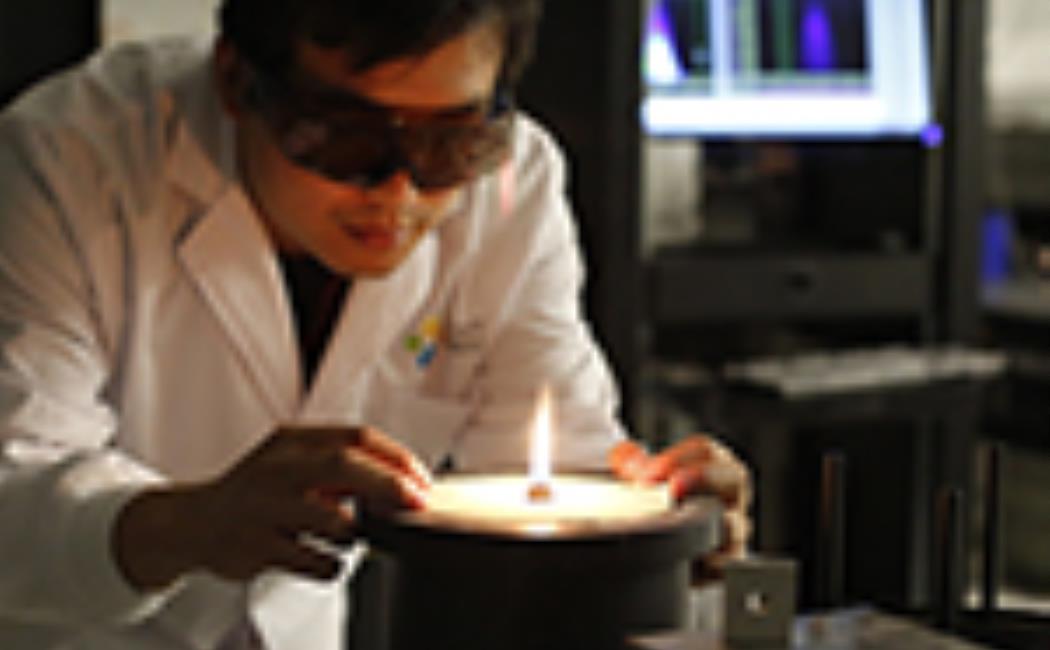


30 April, 2015
Details of the high-pressure columns used in the HPCL. These windows allow the team to insert laser beam for increased heat.
The rising costs of natural gases continue to prompt governments and industry to seek lower cost fuel alternatives. The Kingdom of Saudi Arabia, for instance, is consuming an increasingly large portion of its own fossil fuels on energy requirements such as air conditioning and water. In the search for a solution, crude oils such as Arabian Super Light (ASL) are being considered as primary or backup fuels for heavy-duty gas turbines. General Electric (GE) and KAUST have recently joined forces to explore the feasibility of using crude oil, straight from the ground, to produce energy.
"GE has about five hundred gas turbines in the Kingdom; and they are the largest provider of gas turbines for power generation by far," said KAUST Professor and Director of the Clean Combustion Research Center (CCRC), William Roberts.
Prof. William Roberts, Director of the Clean Combustion Research Center (CCRC)
The highest efficiency gas turbines, called F-class, typically burn natural gas. But the Kingdom has set a specific requirement that some new turbines must also be able to operate on Arabian Super Light or Arabian Extra Light (ASL or AXL), which are unrefined crudes or non-distillates.
"Saudi Arabia doesn't require all its turbines to be optimally designed to burn any fuel, anytime and anywhere. But, for energy security reasons, having the option to rely on unrefined crude in case of emergency is important," said CCRC Laboratory Manager John McIntosh. "Moreover, distilling fuels is very expensive, so there's an economic incentive for further testing."
In order to satisfy the Saudi government's prerequisites, GE has teamed up with KAUST to conduct studies on the development of heavy-duty turbines that would be capable of burning crude oil straight out of the ground. Unlike heavier crudes used to make asphalt, ASL and AXL are categorized as very light crudes. But they still contain traces of vanadium, a highly corrosive metal. Vanadium is a naturally occurring pollutant in oil that is found in the Earth's crust.
The advantage of Arabian Super Light is that it has a very low concentration of vanadium—about 1ppm (part per million). This collaborative research seeks to discover exactly how corrosive this concentration is and what material it must use to manufacture turbines that won't break down under long-term burning of ASL/AXL.
The experiment consists of building a rig at KAUST, through the High Pressure Combustion Laboratory (HPCL), to perform corrosion tests on turbine materials. The rig will burn ASL/AXL crude continuously for 2,000 hours.
A test rig in the HPCL similar to the proposed GE/KAUST setup
A major consideration is how to insulate the test rig to ensure it can withstand extreme pressure and operating temperatures of 900 degrees Celsius or more. As the oil burns, the gases containing the vanadium salts coat the inner walls of the rig. GE carefully selected the HPCL at KAUST as a partner because there are very few laboratories with the capacity to burn crude at such high temperatures and pressures.
As CCRC research technician Jose Maria Silva Corrugedo explained: "We're going to expose different samples during the experiment, to help determine which material is best suited to build the turbines."
Roberts shared: "There are three main issues: efficiency, corrosion and emission for the various fuels that are available not just in the Kingdom but worldwide." The ultimate goal is to understand why vanadium causes corrosion and how that can be prevented.
From the engineering side, the CCRC team wants to look into how to keep the rig operating at high pressure and high temperature without causing the pipes to weaken, leak or blow up. If they get their way, the project will expand to a ten year program, allowing for a greater understanding of corrosion and ultimately leading to significant discoveries to better inform both government and corporate entities.
- by Meres J. Weche, KAUST News
Click here to read this news item on KAUST Discovery where it was originally published.